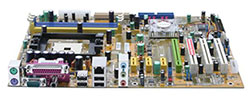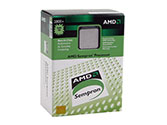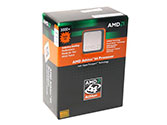Entry Level Buyer’s Guide, July 2005
by Jarred Walton on July 20, 2005 12:05 AM EST- Posted in
- Guides
AMD Recommendations
We have our base recommendation as well as an upgraded recommendation for the AMD side of the equation. The two systems are similar in many areas, but the choice of motherboard, CPU, and graphics card sets them apart.  |
 |
| Click images to enlarge. | |
Budget Socket 754 Motherboard: Foxconn nForce4 NF4K8AB-RS
Price: $78 shipped
Budget Socket 754 CPU: AMD Sempron 2800+ 1.6 GHz 256KB L2 (Retail)
Price: $83 shipped (Retail)
Total: $161
While our basic CPU recommendation remains the same as our last Budget Guide, you'll notice that we've switched motherboards. The main advantage of the Foxconn board is that we get a PCI Express slot, making it a more future-proof solution. Foxconn boards in the past have generally been conservative in approach, but early reports are that this particular board includes overclocking features that should allow you to reach at least a 250 MHz CPU bus if you're interested. (Our own tests with a similar Foxconn board for 939 maxed out at 235 MHz, though, so take those claims with a grain of salt.) The 8X multiplier of the 2800+ is the true limiting factor, giving you a range of 1.8 to 2.4 GHz for a 225 to 300 MHz bus - we figure that the Foxconn board will limit you to 2.0 GHz at best, though we have few doubts that the 90nm Sempron chips can easily run at that speed and more.
If you want better overclocking support, the EPoX EP-8NPAJ or ASUS K8N4-E Deluxe is probably a better choice. Our top pick for socket 754 overclocking continues to be the DFI LANPARTY UT nF3 250Gb, but you'd have to return to an AGP graphics card with the DFI board and we're hesitant to recommend that. The EPoX board only costs another $11, so it's a worthwhile upgrade for the enthusiasts, but the ASUS and DFI boards are quite a bit more expensive. If you're looking at spending that much money on a motherboard, you should probably upgrade to socket 939.
Those interested in cutting costs more can knock off another $11 by dropping to the Sempron 2600+. That has half the cache of the 2800+, but runs at the same clock speed. That should cut performance by about 5 to 7% for a 13% price reduction, but when you look at the total cost of the system, you're really only reducing the price by 2%. Going the other way and upgrading to a Sempron 3000+ or 3100+ is also an option, though the price of the 3100+ is near enough to the Athlon 64 3000+ we list below that we would recommend switching to that platform rather than purchasing a faster Sempron chip.
 |
 |
| Click images to enlarge. | |
Upgraded Socket 939 Motherboard: MSI nForce4 K8N Neo4-F
Price: $85 shipped
Upgraded Socket 939 CPU: AMD Athlon 64 3000+ 1.8 GHz 512KB L2 (Retail Venice core)
Price: $146 shipped (Retail)
Total: $231
For our upgraded AMD setup, we've selected the MSI K8N Neo4-F motherboard with an Athlon 64 3000+. We chose the retail version of the 3000+, though if you're willing to find a suitable HSF, you can get the OEM model for $119 right now. We prefer to avoid the hassle of finding a separate HSF and get the longer warranty, as the total difference in cost after shipping is only about $10. If you want a good overclocking setup, we can vouch for the capabilities of the Neo4-F and the CPU, and when paired with a quality HSF, it's not unusual to hit 2.6 GHz with the Venice cores. We've run some overclocked tests with this CPU and motherboard at 2.2 and 2.4 GHz over a two-week period and didn't experience any difficulties, but your mileage may vary with overclocking.
An alternative to either of these configurations that we've mentioned in the past is the MSI RS480M2-IL 939 board. That includes integrated graphics that are roughly equal to the Radeon X300SE HyperMemory in performance - in other words, the best of the IGP world, but still lacking in 3D performance. While the cost of the board is about the same as that of the Neo4-F, you no longer have to purchase a graphics card. That makes it a wash with the budget setup, but you get a faster CPU. Overclocking is not available on the RS480M2, however, so avoid it if you're interested in tweaking your system for higher performance levels.










57 Comments
View All Comments
wilburpan - Wednesday, July 20, 2005 - link
Regarding Dell: before I read the comments I went over to the Dell website and looked over their current offerings. There are cost cutting measures on the part of Dell to bring the price down on their budget systems: PATA instead of SATA, questionable memory, lack of PCIe, their Celeron based systems come with a maximum of 512 MB RAM, and probaby a bunch more that I don't know about.About this buying guide: some of the recommendations take into account future upgradability. I'm not sure that this should be a real priority for a budget system. One thing that has been made clear to me over the past few years is that building a computer is an exercise in balancing all the components. As a result, once a computer gets very old, it is more cost effective to replace the whole thing rather than upgrading a component at a time. Being that this is a budget system, the lifetime of the components would be less than average, as these components have already been on the market for a while.
bob661 - Wednesday, July 20, 2005 - link
Jarred,In the article you mention that you can do 222 with the OCZ Gold at 2.8V but on OCZ's website it says 3.2V. Can you clarify this?
Zoomer - Wednesday, July 20, 2005 - link
What about motherboards based on the RS482?They offer decent integrated graphics at a good price.
http://www.msi.com.tw/program/products/mainboard/m...
xsilver - Wednesday, July 20, 2005 - link
#12gigabyte makes a fanless 6600GT
costs a few dollars more but if you need it
bupkus - Wednesday, July 20, 2005 - link
I just built a system with an OEM 3000+ Venice for $115, Epox 9NPA+ Ultra for #105 and a Gigabyte X300 for about $70 and now I hear the X700 is the way to go for just a little more. I like to play Ut2004 and that's it. Hmm.. time to rma the X300 and get that X700 before it's too late.I'd consider the 6600GT but I dont' want noisy and I get that impression.
JarredWalton - Wednesday, July 20, 2005 - link
Bah - I caved and listed an optional PSU. I still feel like I keep repeating myself from Guide to Guide, but maybe you readers don't notice it as much? :)10 - PATA is going to be a bit slower and we don't really like the cables. The newer Intel motherboards often come with a single PATA connection (supporting two drives), making it a very poor choice for such motherboards. It *is* an option, but there's a reason PATA drives are getting large mail-in rebates. The same reason such drives often end up in OEM systems: the manufacturers are clearing out old inventory.
Anyway, I don't generally worry much about the mail-in rebate opportunities, as it's basically loaning a company your money at 0% interest for several months. If you can find a good rebate on an SATA drive, I'd prefer that personally, but PATA drives are still okay for some people.
Hacp - Wednesday, July 20, 2005 - link
One question I had was why SATAII? Why not a 40 dollar 80GB PATA100 HD from circuit city or best buy after rebates? I know that those two stores are good for their rebates, and with the 15 dollars you save, you can defenetly upgrade the processor, which is a better bang for your buck in terms of performance.JarredWalton - Wednesday, July 20, 2005 - link
Regarding case and PSU: yes, I realize the PSU is suspect, and I always put better PSUs in computers I build. However, I've also used generic PSUs in budget PCs, and provided the systems aren't overloaded you rarely have problems. At full load, I would guess that the two budget setups will draw 150W or less. If you add in a second hard drive and a more powerful graphics card, you're asking for trouble, but as built they should be fine. Feel free to buy a Fotron Source, Antec, Enermax, etc. - I've suggested it many times and hopefully have made it clear that a nice PSU is never a bad idea.I've got some Dell systems that I use regularly that include Pentium 4 2.8 GHz processors and 1GB of RAM, and they're paired with a (generic) 200W PSU. If Dell thinks a 200W is sufficient for that setup, I'm comfortable with slightly better PSUs for these budget setups.
----------------
As for buying a Dell, that last comment of mine ought to give you something to think about. Dell/HP/etc. often take a good processor like a Pentium 520 and pair it with the cheapest remaining parts that they can find. You'll also get 256MB DIMMs, because no one else wants them these days - upgrading a Dell to 2x512 instead of 4x256 often costs as much as buying 2x512 on your own.
They're still okay, and you can often get a decent LCD with them as well. Upgrading them can often be a frustrating experience, and rarely do they make something an enthusiast would be happy with. If you're okay with that, they're decent systems. I'm not going to do buyers guides picking out OEM systems, though. ;-)
----------------
Finally, I wasn't aware that the low-end Semprons don't support Cool 'n Quiet, but it doesn't matter much to me. They're 90nm parts with 1/2 or 1/4 the L2 cache of the Venice core, so they should run relatively cool already.
I once calculated the cost of running a 60W lightbulb 24/7 for a year and it was only about $37 - 526 kWHrs at 7 cents per kWHr. Cool 'n Quiet on a Sempron isn't likely to save 60W, more like 20W, so the yearly savings would only be around $12. That's enough to upgrade to the next higher Sempron, of course, but if you're looking at the yearly costs it becomes easy to justify buying a much faster PC - at least for me.
Hacp - Wednesday, July 20, 2005 - link
Why not buy a dell? Because Dell offers less performance, few overclocking features, a huge premium for upgrades(ram and dvd rewritable for example), and even crappier graphics than the integrated/turbocached stuff that anandtech is reccomending. Some of the choices are questionable in the article though. The power supply is a major concern.xsilver - Wednesday, July 20, 2005 - link
really #6?didnt know that!
wont it be benefitial to upgrade then as in the long run the cost of a lower power bill will make the cpu pay for itself?